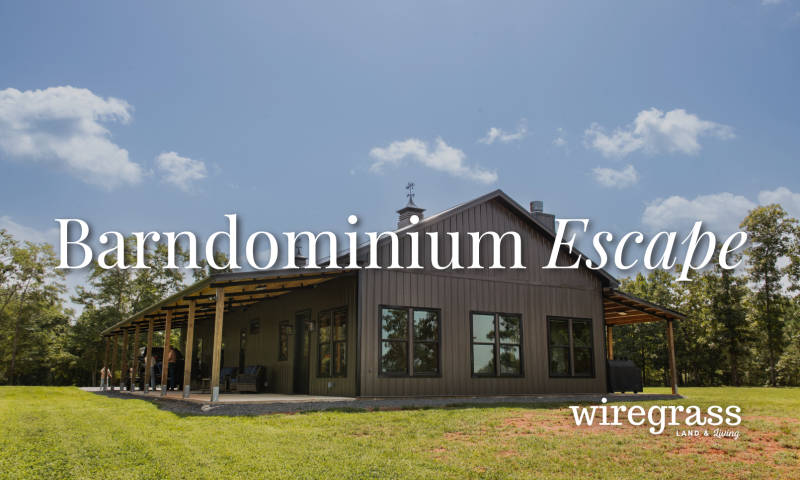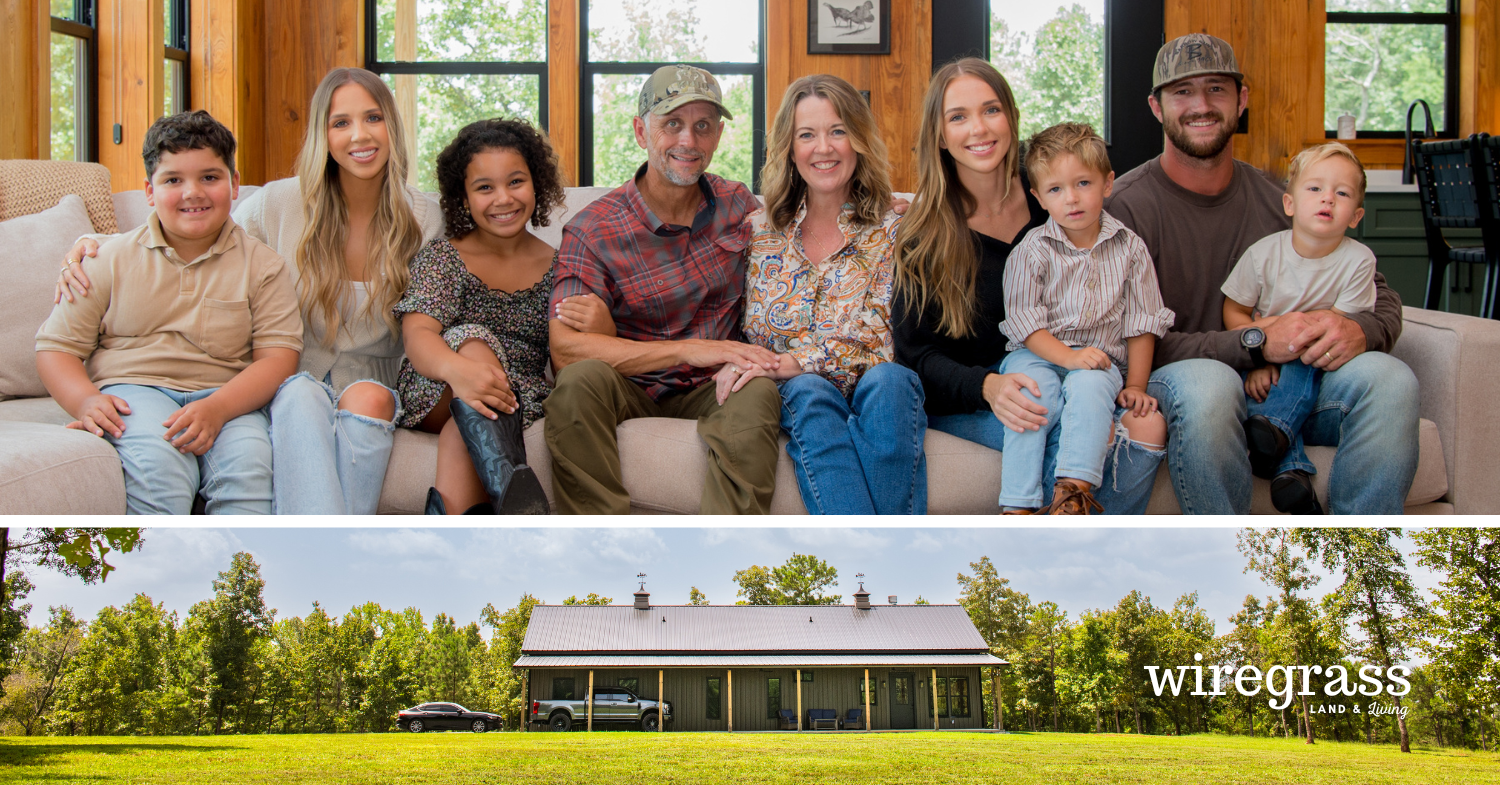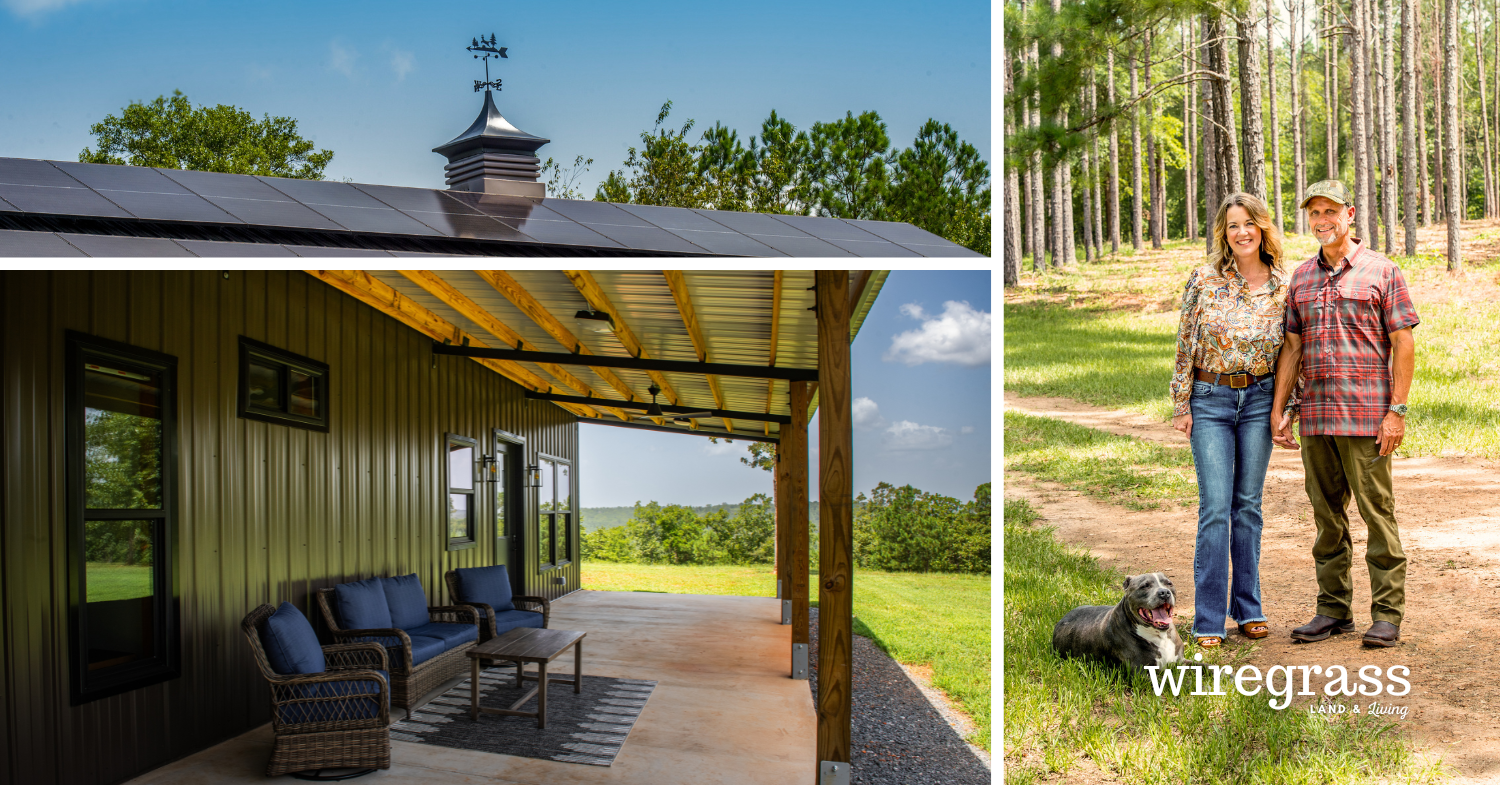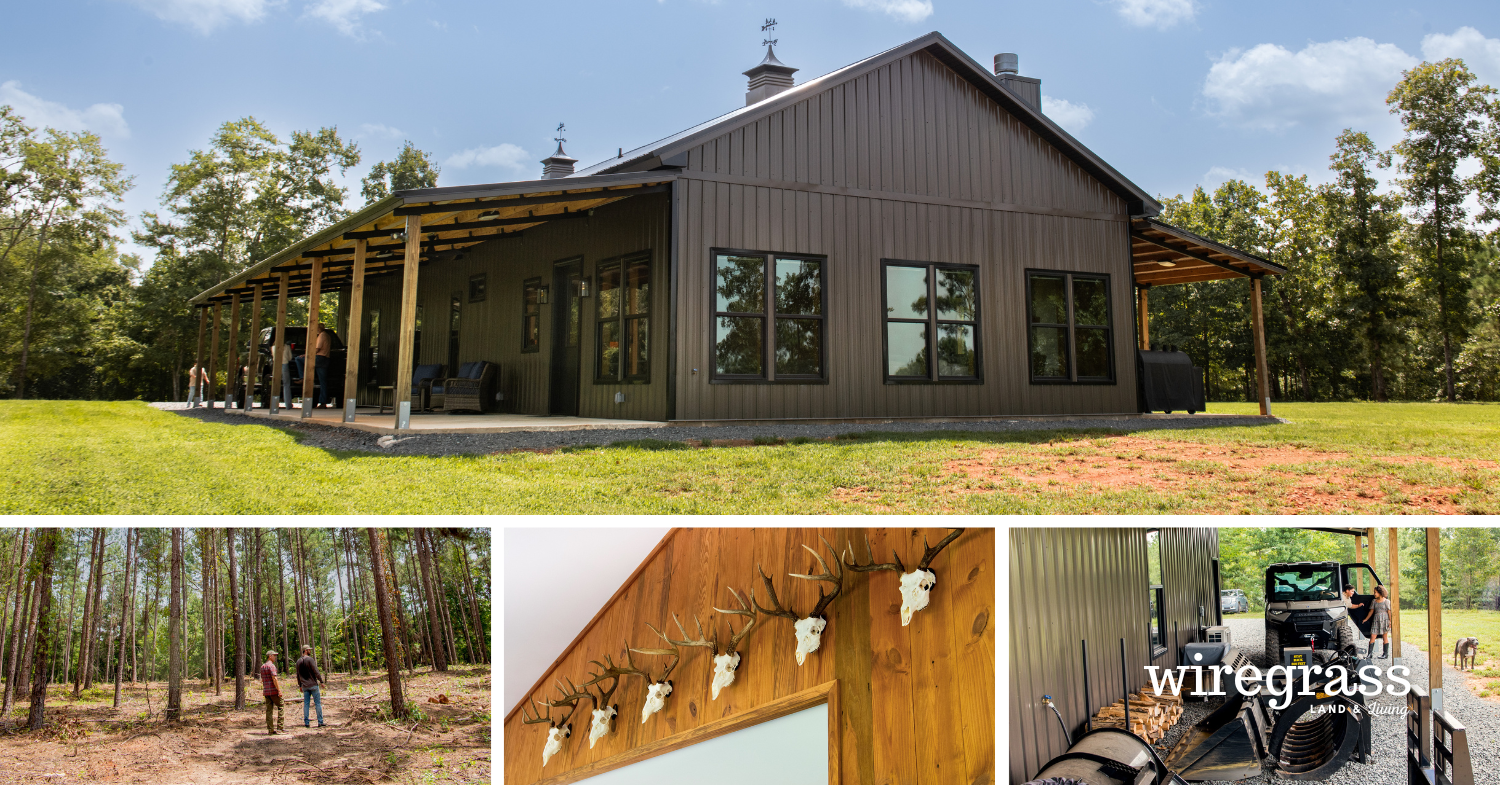Barndominium Escape

From a young age, Ben Giddens had his sights on becoming a landowner. Growing up in Leon County, FL, he had a modest and humble upbringing. He had a passion for the outdoors and loved to hunt and fish with his father, but it was always either on public land or private land that they had permission to use. As an observant kid, he thought how lucky were other families that had their own land to hunt. From that moment on, it became a lifelong dream of Ben’s to own a recreational tract of land, as many acres as he could afford. “A place that I could constantly be working to improve and doing so with my kids and grandkids, sharing my passion for the outdoors with them,” said Ben. “Teaching them to love and care for the land and the critters that live there in hopes they will pass it on to the generations to come.”
Not only did he achieve this goal, Ben and his wife Trena recently constructed a barndominium on almost 300 acres of land to call their own.
The Journey to Landownership
Self-assured that the day would come when he would own land, Ben took time to educate himself. In 2012, Ben and a couple of friends leased a tract in south GA that they put much work, time, and money into. Just when they were starting to benefit from their improvements, they lost the lease, which is not uncommon and all the more reason Ben was saving to purchase his own tract. As time went on, they found another tract to lease, but Ben was more focused than ever to save up and educate himself on how to find and purchase the best recreational tract he could. He conducted research on property appraisers’ websites to find out how much people were paying for land, how long they held onto it, and what their neighbors paid for their properties. He quickly realized that that the more secluded the land was, the cheaper the cost per acre. Other factors that contribute to the value per acre of a tract is the timber value and whether it had irrigated or non-irrigated agricultural fields.
After studying the market and preparing financially, Ben and Trena found a tract in central GA that piqued their interest. Several factors came into play that swayed the Giddens’ decision to purchase this property: It had great potential for a high quality of wildlife with its proximity to the Flint River, and it was easy to access without having to drive through rough terrain. This tract had been clear cut some years ago and the majority of the acreage not replanted in pines. This kept the cost per acre more reasonable while still providing good cover for wildlife. Ben saw the potential in this property becoming a great recreational tract and looked forward to being able to improve it.
But one of the most important qualities of the tract to Ben? The neighbors.
Competition vs. Collaboration
There can be competition and harsh feelings between hunters and landowners who feel possessive of the wildlife that crosses between property lines. For example, rushing to harvest a buck just because you don’t want the adjacent landowner to get it. But something many landowners hope for is collaboration with their neighbors. Ben encourages sharing trail cam pictures and wildlife discussions as opposed to withholding information.
Luckily for Ben, he was introduced to his potential neighbors through a mutual friend before he and Trena even closed on the land. He was nervous to call but was pleasantly surprised to find that they were more than happy for him to purchase the property. They expressed their excitement to have a new neighbor who they felt would improve the land quality and cultivate a healthier habitat for wildlife. Prior to the Giddens, the property had been leased and not managed very well. Although it was farther away than they’d initially hoped for, their neighbors’ enthusiasm, Ben’s passion for wildlife, and the opportunities that the tract presented were enough for them to say “Yes!”

Financing with Farm Credit
From experience financing their primary residence, the Giddens knew that Farm Credit was the best financial lender available to help them tackle their latest investment. Because the Gidden’s property is approximately a 3-hour drive from their residence in Quincy, Ben and Trena envisioned building accommodations on the property to house their growing family while visiting. Mike Harris, a Relationship Manager with Southwest Georgia Farm Credit, understood their goals and was able to provide resources and financing options. When the Giddens mentioned their interest in building a barndominium, Mike was able to adjust the terms of the loan and build in financing before they made it to the closing table.
If there was ever a question or concern the Giddens had, Mike was right there. “Mike took my calls and was always available when I needed him. If I reached out, he was there,” said Ben.
“Business is not rocket science. Do what you say you’re going to do, be straight up with folks, call them back, and provide a good product. A lot of people struggle to do that, but not Mike, not Farm Credit. They treated me the same way I treat my customers, so I was very comfortable from the get-go.”
—Ben Giddens
Building the Barndo
After clearing the property of any trash and debris, the Giddens started preparing the land where their barndominium would go. During construction, Ben and Trena were staying in a tiny 256-square-foot shed that had only a small table, TV, bunk beds, and a window unit. There was no water heater, and they were using a 5-gallon camping shower that they had to leave in the sun to warm up (Of course, “they” quickly turned to only Ben, as Trena quickly decided the camp life was not for her).
Due to location and accessibility, neighbors informed the Giddens that they might have a difficult time finding a building crew. Luckily with Ben’s HVAC background and contracting business, he was able to round up a construction group fairly quickly. His contractors didn’t try to nickel and dime him, Ben stayed on top of things, and everything ran smoothly. Ben’s son-in-law, Logan Smith, is a top-notch carpenter and was a huge help getting the job done. The slab for their barndo was poured in August of 2023, and the Giddens had furniture in by late January 2024. They’d planned a 12-month construction which ended up only taking five.
The barndo is 2,100 square feet—1,500 sq ft is heated and cooled living space with the other 600 sq ft used for enclosed equipment storage. It also features 12ft overhang porches running the 70ft length of the barndo, both front and back. Some of the porch space is used for outdoor living areas, and the rest is for equipment implements. Inside, there are three bedrooms and two bathrooms—One bed and bath for Ben and Trena, and a bedroom for each of their daughters. Their daughters’ rooms both include a queen size bed and twin bunk beds for their kids. If additional sleeping space is needed, there is a large sectional sofa in the living room.
A common theme when constructing the barndo was having enough space but not too much. Ben’s goal was to keep the size down as much as possible while still having the space for their family and equipment. The bedrooms were designed to be just big enough without any wasted space. This allowed for the largest open floor living, dining, and kitchen area they could have, which is where they spend most of their time. During construction, Logan (with Ben acting as his helper) installed the flooring, all the doors, window and door trim, as well as tongue and groove pine for the walls of the living/dining/kitchen space. Together, Ben and Trena along with Logan and their daughter Sarah, Logan’s wife, all pitched in staining the pine and painting the walls and doors. In fact, Trena’s design choices are what make their barndo such a home-y escape. They used Georgia long leaf pine for the walls in the living/dining/kitchen space, as well as the trim on the windows and doors throughout the barndo to give it a touch of that cozy cabin feel.

Off-Grid Living
Due to the lack of utility accessibility that came with the limitation of owning such a remote property, the Giddens invested in off-grid solutions. Because the barndominium was so far from the closest power line, it would have cost the Giddens upwards of $65,000 to have local utility bring power to the site. After tax credits, solar power ended up being slightly more affordable than just the utility company’s fee. The energy cost savings were a huge benefit, too—It usually takes many years to offset the upfront cost of solar equipment. In the Giddens’ case, it was virtually an instant payback. Plus, they’d have no future power bills to pay.
Now, how does solar work exactly? The way Ben explained it is that the whole goal is to store enough power for the nighttime. The solar panels on their barndo are enough to virtually power three homes on a sunny day, but when it goes dark and the panels are useless, battery storage is the most important part. The Giddens have three lithium batteries that hold enough charge to power the barndo. In the wintertime when we are having those cold grey cloudy days, the batteries may not fully charge, so they do have to be more conservative with their usage. As a backup, Ben has the batteries wired with a generator plug and keeps a gas generator on hand so he can charge the batteries if needed. This past winter of 2023, the generator was never needed; however, there was a time or two when the state of charge on the batteries almost required a bit of help from the generator.
When it comes to water, that’s another story. Water isn’t always available where you would like to build. The Giddens’ property is in an area where a good quality well location can be hard to find. The local well driller informed Ben about this challenge and recommended a company that does exploration geophysical surveys and provides a well site selection report. A magnetometer is used to find a facture that holds ground water. The report is amazingly detailed and will give a specific location where a good fracture has been located so the well driller knows where to drill. There was only one quality fracture within a reasonable distance of the barndo location, so this survey and well selection report proved to be very important. Without this report, the well driller would have selected another spot to drill and never hit water. “You’ve got to check those things before you close on the land or select a build site because wells are a per-foot price. You could have an $8,000 well or a $14,000 well depending on how deep or how many times you have to drill before hitting water,” said Ben.
Although the Giddens embraced off-grid living, that may not be everyone’s preference or within their affordability. We always recommend determining what utilities are available from the county and what utilities you may need to make arrangements for. If you plan to build a home or dwelling, there could be restrictions on its location on the property based on where the well and sewage systems can be located. Find out who the state provider or local electric membership cooperative (EMC) is for the property. If power is not already available, talk to the company about the cost of running power to the property and the location of your future home.

The Giddens Now
Ben and Trena are continuing to improve the land for wildlife. They recently harvested some of their pines and are putting the revenue back into the property. With thinning the pines, they’re allowing more sun to hit the floor, attracting a healthier and larger quail and turkey population. They’re also planning a prescribed burn in January which will have many benefits like mitigating wildfire risk, preventing ticks, and reducing understory mass to allow for plants to flower. Ben has worked to improve the quality of his food plots and implemented year-round supplemental feeding utilizing gravity feeders for the deer. Trail camera surveys done in the spring/summer the first year of ownership showed 4-5 decent bucks. This spring/summer (year two) survey is showing a dramatic improvement with 12-15 decent bucks. He plants a variety blend of seed in his plots. The goal is to plant in the spring and again in the fall. These blends have plants that mature at different times of the year, so there’s always something growing that the wildlife are utilizing. Ben is planning to double his food plot acreage over time and has recently added an additional 2 acres to an existing plot. He uses equipment for planting and the overall maintenance of the land—a tractor and skid steer with several implements. So many turkeys have shown up on the property that they’re now treating them as pets.

“If you treat a piece of property right, you can dramatically change the land for the better.”
—Ben Giddens
Now, Ben and Trena have the retreat they’d always hoped for that feels like a second home their family can drive up and stay in as well. They’re only 40 minutes away from cities like Macon and Columbus, so the ladies in the family can go shopping while the men are out hunting. “My advice? Have some place your wife is going to want to go as well,” said Ben. In the mornings, the Giddens enjoy their coffee on the porch watching the cloud bank from the hill their barndo is perched on with wild turkeys strolling through their yard.

Hunting is their main use of the property, which is set up primarily for archery hunting, so they have a small archery range for practice. When the family isn’t hunting, Ben spends majority of the off-season continuing improvements. “I enjoy working on the land improvements as much as the hunting, maybe more,” said Ben. “It’s very satisfying to be on the land, working on various projects, and seeing the quality of the wildlife and property improving.” The Giddens also enjoy looking for Native American artifacts with their family and riding their ATVs down the miles of dirt roads around the land.
Mike Harris still keeps in touch with the Giddens for updates on the family and what improvements they’re working on. “There’s no doubt with the improvements Ben and Trena have made, they have increased the value of their property,” said Mike. “I knew really quickly working with Ben and Trena that they had a good plan. It wasn’t just on a whim, so I wanted to go the extra mile to find a solution for what they wanted because it isn’t conventional. They’ve both worked hard to get where they are, and they’ve made the sacrifices to have the funds available to do it. Responding to his calls was the easy stuff, but having somebody that’s willing to be patient so you can structure their loan where it’ll work for them was really the success here.”

Ready to Leave Your Own Legacy?
If you've been wanting to invest in a tract of land to call your own, whether it's large or small acreage, recreational, farmland, or a future homesite, click the button below to get in touch with us!